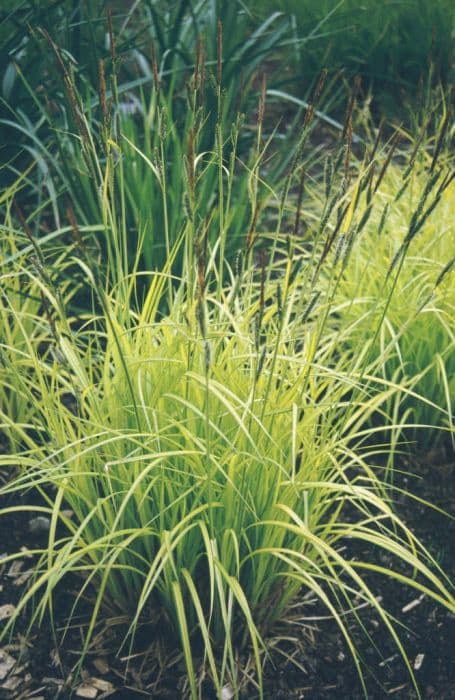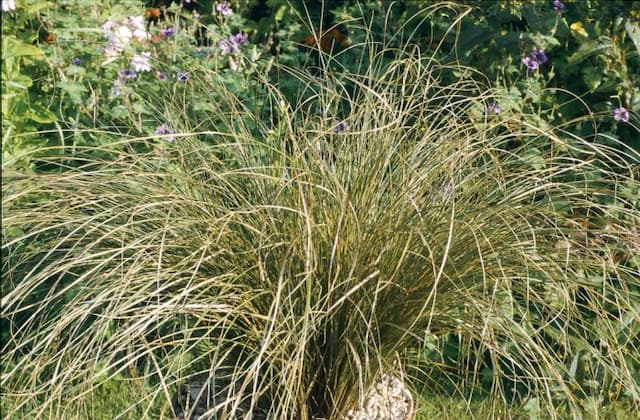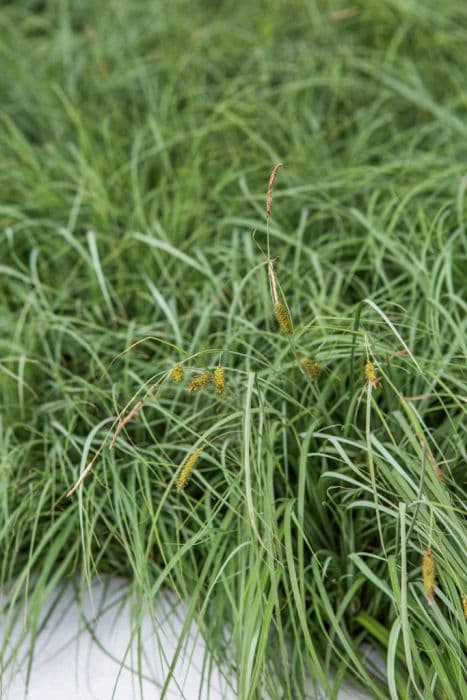Hop Sedge Carex pseudocyperus
















ABOUT
Carex pseudocyperus, commonly known as hop sedge, is a perennial grass-like plant with a distinctive appearance that features a clumping growth habit. The plant is characterized by its arching, bright green leaves which have a somewhat coarse texture. These leaves are long and narrow with a slightly rough edge, emanating from a central base to create a dense tuft. Hop sedge produces flowering spikes that are somewhat unique in appearance, typically a yellowish-green or brownish color, which bear a resemblance to the cones of hop plants, thus giving it the common name 'hop sedge.' These spikes are dense, elongate, and pendulous, clustered at the top of tall, triangular stems that are solid and rough to the touch. The seed heads of the hop sedge are notable for their inflated appearance, which occurs when the seeds begin to mature. The seeds themselves are enclosed within small, sack-like structures that are green initially but turn to brown as they mature, giving the seed head an interesting textured look. Hop sedge's overall appearance can be quite lush and its long leaves sway gracefully in the wind, creating an effect that is both striking and serene in a wetland or garden setting. The foliage tends to remain attractive throughout the growing season, adding to the plant's ornamental value.
About this plant
 Names
NamesFamily
Cyperaceae.
Synonyms
Cypress-like Sedge, False Cypress Sedge.
Common names
Carex filiformis, Carex riparia, Vignea pseudocyperus, Vignea riparia.
 Toxicity
ToxicityTo humans
The plant known as Hop Sedge (Carex pseudocyperus) is not commonly recognized for having toxic effects on humans. There is no significant data indicating that Hop Sedge has poisonous attributes that would result in symptoms of poisoning in humans after ingestion or contact. However, it's always good to exercise caution and avoid ingesting plants not known to be safe for consumption.
To pets
Similar to the information for humans, Hop Sedge (Carex pseudocyperus) does not have a known toxic effect on pets. There are no well-documented cases of pet poisoning from ingestion of or contact with this plant. As always, pet owners should prevent pets from consuming non-food plants as a precaution.
 Characteristics
CharacteristicsLife cycle
Perennials
Foliage type
Deciduous
Color of leaves
Green
Flower color
Brown
Height
2-3 feet (60-90 cm)
Spread
1-2 feet (30-60 cm)
Plant type
Herb
Hardiness zones
5
Native area
Europe
Benefits
 General Benefits
General Benefits- Wildlife Habitat: Carex pseudocyperus, also known as Hop Sedge, provides a natural habitat for various wildlife, including birds and insects, offering them shelter and food sources.
- Erosion Control: Hop Sedge has a robust root system that helps stabilize soil, reducing erosion along riverbanks and in wet areas.
- Water Quality Improvement: The roots of Hop Sedge help filter contaminants from water, playing a role in improving water quality in wetland ecosystems.
- Aesthetic Appeal: With its grass-like appearance and tendency to grow in clumps, Hop Sedge adds a unique textural element to natural looking gardens and landscapes.
- Biodiversity Support: Hop Sedge contributes to ecosystem diversity, providing the necessary plant variety that supports a healthy and balanced habitat.
- Native Landscaping: Being a native species in many areas, Hop Sedge is well-suited for native and sustainable landscapes, requiring less maintenance compared to non-native plants.
- Soil Moisture Conservation: The dense growth of Hop Sedge helps conserve soil moisture, which can be beneficial for surrounding plants in a diverse ecosystem.
 Medical Properties
Medical PropertiesThis plant is not used for medical purposes.
 Air-purifying Qualities
Air-purifying QualitiesThis plant is not specifically known for air purifying qualities.
 Other Uses
Other Uses- Carex pseudocyperus, commonly known as Hops sedge, has been used in the construction of traditional small hand brooms, due to its stiff foliage.
- In some cultures, the stems of Hops sedge have been woven into mats or rough textiles for utilitarian purposes.
- The dense, fibrous structure of Hops sedge can be used as a form of natural stuffing in upholstery or homemade dolls.
- This plant has historical significance in folk art, where it might be incorporated into decorative pieces for its unique seed head structure.
- Hops sedge can be used in landscape design as part of bioengineering projects, aiding in soil erosion control due to its sturdy root system.
- Dried Hops sedge has been used in some regions to create rustic, eco-friendly packaging materials.
- The sedge's seed heads have found a place in floral arrangements, dried bouquets, and craft projects to add a natural, wild texture.
- In historical times, some communities would use Hops sedge as a material for thatching small shelters or huts.
- This plant can serve as a source of biomass for composting, contributing to a more sustainable garden ecosystem.
- Children in some rural areas have used the lightweight stems of Hops sedge to fashion simple, temporary toys or tools for outdoor play.
Interesting Facts
 Feng Shui
Feng ShuiThe Hop Sedge is not used in Feng Shui practice.
 Zodiac Sign Compitability
Zodiac Sign CompitabilityThe Hop Sedge is not used in astrology practice.
 Plant Symbolism
Plant Symbolism- Adaptability: Carex pseudocyperus, commonly known as the Hop Sedge, thrives in a variety of wetland habitats, symbolizing the ability to adapt and grow in changing environments.
- Resilience: As the Hop Sedge can survive in areas with fluctuating water levels, it represents resilience and the capacity to endure challenges and recover.
- Protection: The dense growth patterns of the Hop Sedge can provide shelter for small wildlife, hence, it symbolizes protection and the importance of creating safe havens.
- Nurturing: The Hop Sedge's role in its ecosystem, including its formation of a habitat and its part in water filtration, epitomizes the nurturing of natural processes and the support of life.
 Water
WaterThe Cyperus Sedge (Carex pseudocyperus) prefers consistent moisture and should be watered thoroughly whenever the top inch of soil feels dry to the touch. Typically, this might be once or twice a week, depending on climate conditions and the plant's environment. Use about 1-2 gallons of water per plant for each watering session to ensure the soil is moistened evenly throughout the pot or planting area. Overwatering can cause root rot, so it’s important to ensure good drainage and avoid letting the plant sit in standing water.
 Light
LightCyperus Sedge thrives best in full to partial sunlight. It can do well in a variety of lighting conditions but prefers a spot where it receives at least four hours of direct sunlight daily. Too little light can lead to sparse growth, while too much direct sunlight, especially in hotter climates, might scorch the leaves, so a balance is ideal.
 Temperature
TemperatureCyperus Sedge does well in a wide range of temperatures, typically between 35°F and 85°F. The ideal temperature range for this plant is between 50°F and 70°F. It's cold-hardy and can survive slight frosts but should be protected from prolonged exposure to temperatures below freezing.
 Pruning
PruningPruning Cyperus Sedge is mainly done to remove dead or yellowing foliage to maintain a neat appearance and encourage healthy growth. Trim away the older outer leaves at the base several times during the growing season. The best time to prune is in late winter or early spring before new growth begins.
 Cleaning
CleaningAs needed
 Soil
SoilThe best soil mix for Hop sedge (Carex pseudocyperus) should be rich, moist, and well-draining, with a substantial amount of organic material like peat or compost to retain moisture. A slightly acidic to neutral pH, ranging from 5.5 to 7.0, will suit this plant well. To promote good root health, consider adding some sand or perlite to enhance drainage.
 Repotting
RepottingHop sedge (Carex pseudocyperus) generally does not require frequent repotting and can be done every 2 to 3 years, but it should be monitored for signs it has outgrown its pot, like roots growing through the drainage holes.
 Humidity & Misting
Humidity & MistingHop sedge (Carex pseudocyperus) thrives in high humidity conditions, ideally between 50-70%. It is often found in naturally moist environments, so replicating these conditions will help the plant grow well.
 Suitable locations
Suitable locationsIndoor
Place Hop sedge in bright, indirect light and maintain high humidity.
Outdoor
Plant Hop sedge in damp, partially shaded areas.
Hardiness zone
5-9 USDA
 Life cycle
Life cycleCarex pseudocyperus, commonly known as Hop Sedge, begins its life cycle with seed germination, which occurs in wet soil conditions often along the margins of water bodies. Once germinated, the seedling establishes roots and produces shoots, and its growth is marked by the development of long, grass-like leaves. The plant then matures and forms dense clumps as it enters its vegetative stage characterized by vigorous growth. Sexual reproduction follows when Hop Sedge develops inflorescences on triangular stems, producing monoecious flowers, with separate male and female flowers on the same plant. Following pollination, typically by wind, the plant produces fruits called utricles, which when mature, release seeds into the surrounding water or wet soil, completing the lifecycle. Hop Sedge is a perennial plant, so this cycle of vegetative growth and reproduction may occur annually over several years.
 Propogation
PropogationPropogation time
Spring to summer
The most popular method of propagation for Carex pseudocyperus, commonly known as Hop Sedge, is by division. This straightforward technique involves carefully separating the plant's clumps into smaller sections, making sure that each new section has a portion of the root system intact. Propagation by division is best done in the late winter or early spring, just before the growing season begins. To propagate Hop Sedge by division, dig up an established plant and gently tease apart the clump into smaller pieces. Each piece should contain several shoots and a healthy set of roots. These divisions can then be replanted immediately at the same depth they were growing at before, spaced about 12 inches (30 centimeters) apart to allow adequate room for growth. This method ensures that the new plants are true to the parent plant and will establish quickly in the garden.








![Japanese sedge [Everest]](/_next/image?url=https%3A%2F%2Fplants-admin.emdemapps.com%2Fimages%2Fplants%2F%2Fimages%2F604b5b6de0548.png&w=640&q=75)
